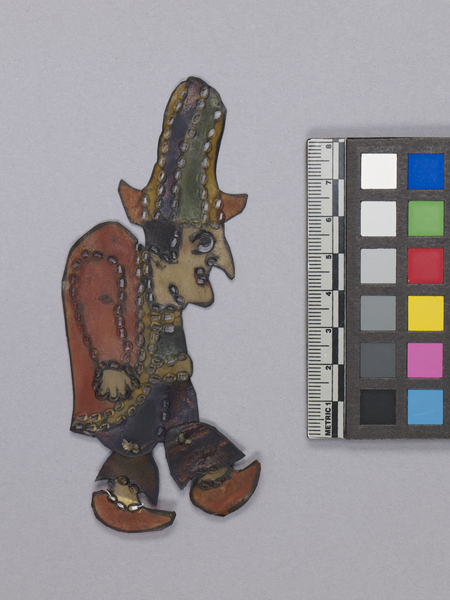Shadow Puppet Item Number: 3084/4 from the MOA: University of British Columbia

Description
Shadow puppet of the hunchback character Bekeruhi, made of semi-transparent animal skin and a watery paint. The man wears a tall rounded hat with brim, striped in green, blue, yellow and red, as well as an open jacket above a green shirt, wide legged dark pants and red shoes. His face has a long pointed nose, prominent round chin, open mouth and large downturned eye. The hump on his back is prominent. The legs below the knees are separate from the body and attached with small string ties in order to create movement. The skin of the object is punctured to delineate lines in the clothing and divisions between his limbs.
History Of Use
Shadow puppet character, from the Turkish shadow play known as "Karagöz & Hacivat". The play dates back to the Ottoman Empire (c. 1299-1923). It follows the escapades and fights of the two central characters from whom it takes its name. These friends are opposites in many ways: Karagöz (Black Eye) is illiterate and coarse, but well-intentioned, and very funny. Whereas Hacivat is pretentious and conceited, well-spoken and amusing. The plays are full of wit and satire and social and ethnic stereotypes as well as supernatural characters, such as monsters and magicians. Karagöz shadow puppetry was inscribed on UNESCO’s List of the Intangible Cultural Heritage of Humanity in 2009.
Narrative
Collected by the donor in Istanbul in the early 1970s.
Item History
- Made in Turkey before 1970
- Collected in Istanbul, Turkey
- Owned by Rudi Kovanic before October 31, 2014
- Received from Rudi Kovanic (Donor) on October 31, 2014
What
- Name
- Shadow Puppet
- Identification Number
- 3084/4
- Type of Item
- puppet
- Material
- skin, paint and cotton fibre
- Overall
- height 12.5 cm, width 4.8 cm, depth 0.2 cm
Who
- Culture
- Turkish
- Previous Owner
- Rudi Kovanic
- Received from
- Rudi Kovanic (Donor)
Where
- Holding Institution
- MOA: University of British Columbia
- Made in
- Turkey
- Collected in
- Istanbul, Turkey
When
- Creation Date
- before 1970
- Ownership Date
- before October 31, 2014
- Acquisition Date
- on October 31, 2014
Other
- Condition
- excellent
- Accession Number
- 3084/0004